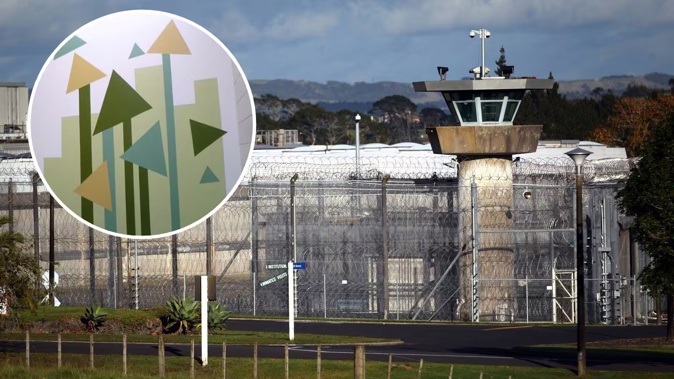
The Department of Corrections spent more than $400,000 on a makeover – complete with a fresh paint job and colourful designs – of the prison unit housing New Zealand’s most notorious criminals, including mosque terrorist Brenton Tarrant.
The costly renovation at the Prisoners of Extreme Risk Unit (Peru) inside Auckland Prison – also known as Paremoremo – was carried out over the past couple of months to address reports which classed it as “oppressive” and “inhuman”.
Peru was established in 2019, four months after the March 15 terror attack.
At the end of 2024, it housed 13 of the country’s most violent and dangerous inmates, including Tarrant, who murdered 51 worshippers and injured 40 others at the Al Noor and Linwood mosques in Christchurch.
The Herald revealed last month that maintenance work was being carried out in the 18-cell unit to address feedback from the Ombudsman and Office of the Inspectorate reports, and “create an environment that’s less stark and therefore more conducive to rehabilitating prisoners and better for our staff”.
The work included repainting the unit’s visiting booths, entrance foyer, day rooms, yards and cells for the first time since it was built in 2018.

Each of the 18 cells adjoining individual yards were painted with the same abstract landscape design. Photo / Department of Corrections
Images shared by Corrections show inmates’ cells painted green and a wall in their adjoining individual yards with a colourful “geometric design” painted on a wall in the yard, where they are allowed to exercise for three to six hours daily.
Now, figures released to the Herald under the Official Information Act (OIA) have revealed the total cost of the project was $407,307 – a sum Corrections say was funded from within its existing baselines as part of Budget 2025.
Among this, $260,964 was spent on what was described as “painting preparations” – including chemical washing to remove old paint, graffiti and dirt – and repainting the unit.
Corrections said the unit painting included two day rooms, two large exercise yards, the unit’s entrance foyer area and hallways, the visiting areas, 17 standard cells and their adjoining exercise yards, one accessibility cell with adjoining yard, and two dry cells.

Inmates' cells have been painted green in a bid to lift their "oppressive" surroundings. Photo / Department of Corrections
The remaining $146,343 was spent on placing “geometric designs” on the walls of two large exercise yards, two day rooms, the visitor areas, the unit’s entrance foyer and hallway areas, and the cell yards.
The Department of Corrections’ commissioner of custodial services, Leigh Marsh, said they were required to use specialist paint that is resistant to graffiti and vandalism “given the nature of those we manage in prison”.
“While the upfront cost of this paint can be higher in the short term, it can help reduce long-term costs.”
The Herald understands Corrections hired a commercial painting company to carry out the project – as it required working at heights.
“This maintenance work in Peru also required scaffolding to meet health and safety requirements. The work has also had to be done in stages and outside of usual hours to ensure the safety of those undertaking the work. All of these factors impact the cost of maintenance in this unit,” Marsh said.

Images from inside the Prisoners of Extreme Risk Unit (Peru) in Auckland Prison during a 2023 inspection. Photo / Office of the Inspectorate
Marsh said the condition of prison environments can impact inmates’ willingness to take part in rehabilitation, and the levels of tension and aggression towards frontline staff and other prisoners.
“Creating brighter spaces within prisons, especially in areas frequently used by staff, visitors, and prisoners, is common and something Corrections has done in prisons for many years.
“Work like this can often be carried out by prisoners to keep them engaged in constructive activities and help their rehabilitation. However, this is not possible in the Peru due to the unit’s security classification and operational routines.”
‘Incredibly austere environment’, convicted killer says
Convicted killer turned motivational speaker Dr Paul Wood spent almost a year locked up in Paremoremo, which he told the Herald last month was “without question” New Zealand’s toughest prison.
“It’s an incredibly austere environment. I do definitely think that is not good for mental health, resilience, ability to cope, any of those things,” Wood said.
He was housed in the prison’s maximum security unit after pleading guilty to killing his drug dealer at the age of 18. The man attempted to sexually assault Wood before the teenager bludgeoned him to death with a baseball bat.
“I think the paint and the mural creates greater visual diversity and different engagement, and there is research around this in terms of the impact on mood and behaviour.

Convicted killer turned motivational speaker Dr Paul Wood.
“However, I would consider this stuff to be very much nice to do rather than some of the key things which are still massively underfunded in the system ... It does have an impact [but] the biggest impact would be having more resources within Corrections devoted to rehabilitative programmes.”
Wood said those who come from a normal, visually rich environment, like most people in New Zealand, would find it hard to grasp an understanding of what it’s like inhabiting a truly austere environment.
“I think it’s important that we sort of suspend our judgments on the impact that might have on us relative to someone who’s actually been long-term deprived of any kind of visual variety or stimulation.”
He recalled that when he was first released from prison, he was overwhelmed when walking down a supermarket confectionery aisle because the colours were in contrast to the prison environment.
Benjamin Plummer is an Auckland-based reporter who covers breaking news. He has worked for the Herald since 2022.
Take your Radio, Podcasts and Music with you









